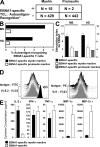EBNA1-specific T cells from patients with multiple sclerosis cross react with myelin antigens and co-produce IFN-gamma and IL-2
- PMID: 18663124
- PMCID: PMC2525578
- DOI: 10.1084/jem.20072397
EBNA1-specific T cells from patients with multiple sclerosis cross react with myelin antigens and co-produce IFN-gamma and IL-2
Abstract
Symptomatic primary Epstein-Barr virus (EBV) infection and elevated humoral immune responses to EBV are associated with an increased risk of developing multiple sclerosis (MS). We explored mechanisms leading to this change in EBV-specific immunity in untreated patients with MS and healthy virus carriers matched for MS-associated HLA alleles. MS patients showed selective increase of T cell responses to the EBV nuclear antigen 1 (EBNA1), the most consistently recognized EBV-derived CD4(+) T cell antigen in healthy virus carriers, but not to other EBV-encoded proteins. In contrast, influenza and human cytomegalovirus-specific immune control was unchanged in MS. The enhanced response to EBNA1 was mediated by an expanded reservoir of EBNA1-specific central memory CD4(+) T helper 1 (Th1) precursors and Th1 (but not Th17) polarized effector memory cells. In addition, EBNA1-specific T cells recognized myelin antigens more frequently than other autoantigens that are not associated with MS. Myelin cross-reactive T cells produced IFN-gamma, but differed from EBNA1-monospecific cells in their capability to produce interleukin-2, indicative of a polyfunctional phenotype as found in controlled chronic viral infections. Our data support the concept that clonally expanded EBNA1-specific CD4(+) T cells potentially contribute to the development of MS by cross-recognition of myelin antigens.
Figures





Similar articles
-
Increased frequency and broadened specificity of latent EBV nuclear antigen-1-specific T cells in multiple sclerosis.Brain. 2006 Jun;129(Pt 6):1493-506. doi: 10.1093/brain/awl067. Epub 2006 Mar 28. Brain. 2006. PMID: 16569670
-
Heightened Epstein-Barr virus immunity and potential cross-reactivities in multiple sclerosis.PLoS Pathog. 2024 Jun 6;20(6):e1012177. doi: 10.1371/journal.ppat.1012177. eCollection 2024 Jun. PLoS Pathog. 2024. PMID: 38843296 Free PMC article.
-
In-depth analysis of serum antibodies against Epstein-Barr virus lifecycle proteins, and EBNA1, ANO2, GlialCAM and CRYAB peptides in patients with multiple sclerosis.Front Immunol. 2024 Dec 17;15:1487523. doi: 10.3389/fimmu.2024.1487523. eCollection 2024. Front Immunol. 2024. PMID: 39742283 Free PMC article.
-
EBV-specific T-cell immunity: relevance for multiple sclerosis.Front Immunol. 2024 Dec 24;15:1509927. doi: 10.3389/fimmu.2024.1509927. eCollection 2024. Front Immunol. 2024. PMID: 39776919 Free PMC article. Review.
-
Epstein-Barr virus evasion of CD8(+) and CD4(+) T cell immunity via concerted actions of multiple gene products.Semin Cancer Biol. 2008 Dec;18(6):397-408. doi: 10.1016/j.semcancer.2008.10.008. Epub 2008 Oct 25. Semin Cancer Biol. 2008. PMID: 18977445 Review.
Cited by
-
Multiple sclerosis.J Clin Invest. 2012 Apr;122(4):1180-8. doi: 10.1172/JCI58649. Epub 2012 Apr 2. J Clin Invest. 2012. PMID: 22466660 Free PMC article. Review.
-
Epstein-Barr virus: Biology and clinical disease.Cell. 2022 Sep 29;185(20):3652-3670. doi: 10.1016/j.cell.2022.08.026. Epub 2022 Sep 15. Cell. 2022. PMID: 36113467 Free PMC article. Review.
-
Epstein-Barr virus in systemic lupus erythematosus, rheumatoid arthritis and multiple sclerosis—association and causation.Viruses. 2012 Dec;4(12):3701-30. doi: 10.3390/v4123701. Viruses. 2012. PMID: 23342374 Free PMC article. Review.
-
Epstein-Barr Virus Infection in the Development of Neurological Disorders.Drug Discov Today Dis Models. 2020 Fall;32(Pt A):35-52. doi: 10.1016/j.ddmod.2020.01.001. Epub 2020 Feb 19. Drug Discov Today Dis Models. 2020. PMID: 33897799 Free PMC article.
-
Polyreactive monoclonal autoantibodies in multiple sclerosis: functional selection from phage display library and characterization by deep sequencing analysis.Acta Naturae. 2013 Oct;5(4):94-104. Acta Naturae. 2013. PMID: 24455188 Free PMC article.
References
-
- Sundstrom, P., P. Juto, G. Wadell, G. Hallmans, A. Svenningsson, L. Nystrom, J. Dillner, and L. Forsgren. 2004. An altered immune response to Epstein-Barr virus in multiple sclerosis: a prospective study. Neurology. 62:2277–2282. - PubMed
-
- Banwell, B., L. Krupp, J. Kennedy, R. Tellier, S. Tenembaum, J. Ness, A. Belman, A. Boiko, O. Bykova, E. Waubant, et al. 2007. Clinical features and viral serologies in children with multiple sclerosis: a multinational observational study. Lancet Neurol. 6:773–781. - PubMed
-
- Thacker, E.L., F. Mirzaei, and A. Ascherio. 2006. Infectious mononucleosis and risk for multiple sclerosis: a meta-analysis. Ann. Neurol. 59:499–503. - PubMed
-
- Nielsen, T.R., K. Rostgaard, N.M. Nielsen, N. Koch-Henriksen, S. Haahr, P.S. Sorensen, and H. Hjalgrim. 2007. Multiple sclerosis after infectious mononucleosis. Arch. Neurol. 64:72–75. - PubMed
Publication types
MeSH terms
Substances
Grants and funding
LinkOut - more resources
Full Text Sources
Other Literature Sources
Medical
Research Materials

